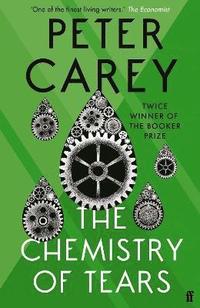The Chemistry of Tears

Författare: Peter Carey
Genre: Roman
Ämnesord: historia, kärlek, teknik
Utgivningsår: 2012
ISBN: 9780571280018
Genre: Roman
Ämnesord: historia, kärlek, teknik
Utgivningsår: 2012
ISBN: 9780571280018


Köp boken på amazon.se (betald länk)
* Som Amazon-associates tjänar vi pengar på kvalificerade köp.
Begagnade:

London 2010. Catherine Gehrig, conservator at the Swinburne museum, learns of the unexpected death of her colleague and lover of thirteen years. As the mistress of a married man she has to grieve in private. One other person knows their secret, the director of the museum, who arranges for Catherine to be given a special project away from prying eyes. Mad with grief, the usually controlled and rational Catherine discovers a series of handwritten notebooks telling the story of the man who originally commissioned the extraordinary and eerie automata she has been asked to bring back to life. With a precocious new assistant, Amanda, at her side, she starts to piece together both the clockwork puzzle and the story of the mechanical creature which was commissioned in 19th century Germany by an English man, Henry Brandling, as a 'magical amusement' for his consumptive son. Having been asked to leave his home by his wife, Henry turns his hurtful departure into an adventure that he records for his young child. But it is Catherine Gehrig, in a strangely stormy and overheated London nearly two hundred years later, who will find comfort and wonder in reading Henry's story. And it is the automata, in its beautiful, uncanny imitation of life that will link two strangers confronted with the mysteries of life and death, the miracle and catastrophe of human invention and the body's astonishing chemistry of love and feeling.
Utdrag ur boken:
When my little fellow saw the design for M Vaucanson's ingenious duck, a great shout - huzza - went up from him. It was a tonic to see the colour in his cheeks, the life brimming in his eyes where I observed the force of what Dr Kneipp calls 'magnetic agitation' which is a highly elevateted form of curiosity or desire.
I thought, dear Lord, we have turned the corner.
The ten sheets of plans covered his bed. 'Oh Papa', he said, 'it is a wonder'.
Bok recensioner av The Chemistry of Tears :
2013-11-17 11:48
Två historier och två berättarjag, den nutida huvudpersonen upptäcker i samband med musealt arbete en berättelse från 1840-talet nedtecknad av en far som drar igång ett teknikutvecklingsprojekt i syfte att rädda livet på sin son. Nutid och historia varvas och det visar sig att projektet kan ha fått oåterkalleliga sidoeffekter på teknikutvecklingen och världshistorien... Mitt betyg 4.33 (av 5.0).
Betyg 4


"
Köp boken på amazon.se (betald länk) * Som Amazon-associates tjänar vi pengar på kvalificerade köp.
Skriv egen bokrecension till The Chemistry of Tears
Liknande böcker:
Sibirisk uppfostran
N. Lilin
N. Lilin
Var försiktig Clary Brown
C. Keppel
C. Keppel
Sanningens Ögonblick
K. Hannah
K. Hannah
Ta hand om min mor
K. Shin
K. Shin
Nattens tårar
M. Sandemo
M. Sandemo
Drakarnas imperium två..
V. Massimo Manfredi
V. Massimo Manfredi
Kronjuvelerna
C. Dahl
C. Dahl
Kriget Vid Världens Ände
M. Vargio IIosa
M. Vargio IIosa
Färskt vatten till blo..
V. Perrin
V. Perrin
En drottnings löfte
C. Gortner
C. Gortner
